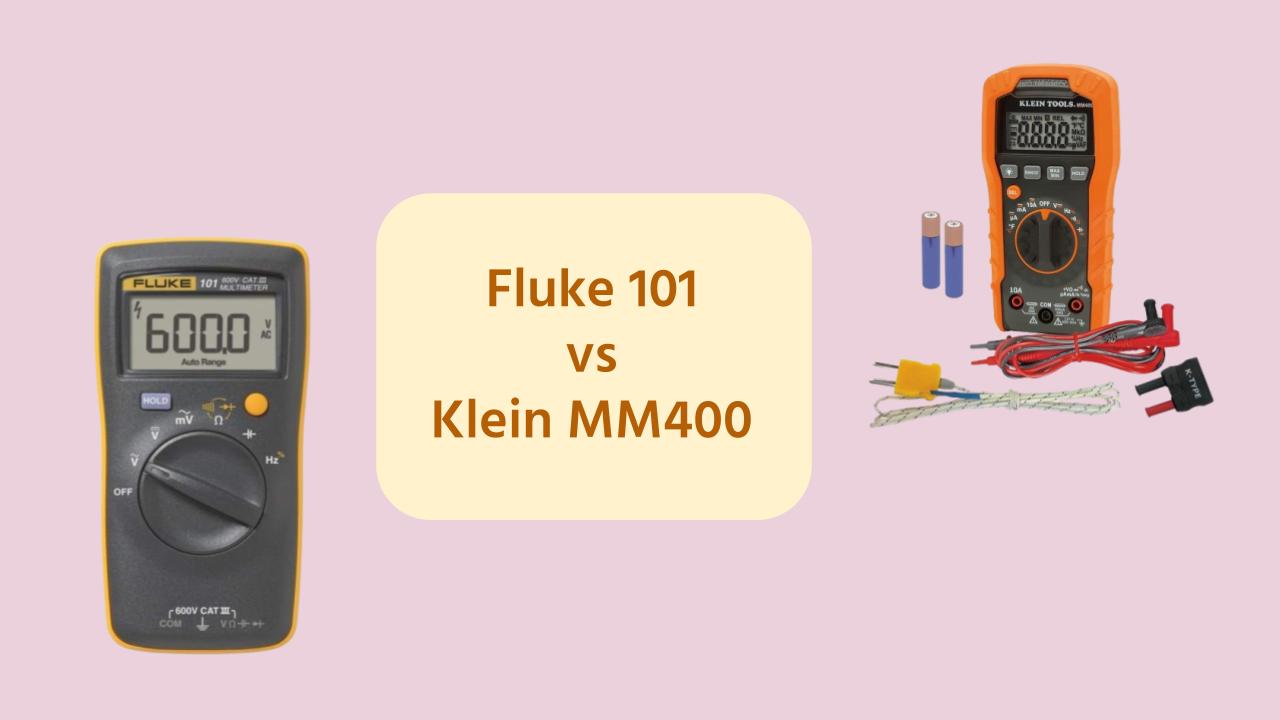In this post we compare two basic multimeters from Fluke and Klein Tools.
This article will delve into a comparative analysis of these two models, examining their technical specifications, usability, and functionality to help you make an informed decision.
The Klein MM400 offers more versatile features like temperature measurement , while the Fluke 101 stands out for its simplicity and high-resolution display in a compact design.
🏷️ Fluke Multimeter Deals ⭐⭐⭐⭐⭐
In this article, we will delve into a detailed comparison of the Fluke 101 and Klein MM400 multimeters.
Table of Contents
Comparison Table: Fluke 101 vs Klein MM400
| Specification | Fluke 101 | Klein MM400 |
|---|---|---|
| 💳 Price | Check Price | Check Price |
| Voltage Measurement | Up to 600V AC/DC | Up to 600V AC/DC |
| Current Measurement | Not available | Up to 10A AC/DC ✅ |
| Resistance Measurement | Up to 40 MΩ | Up to 40 MΩ |
| Capacitance Measurement | Up to 100 μF | Up to 200 μF ✅ |
| Frequency Measurement | Not available | Yes, up to 500 kHz ✅ |
| Continuity Check | Yes | Yes |
| True RMS | No | Yes ✅ |
| Auto-ranging | Yes | Yes |
| Display | 6000 counts, 3 ½ digits | 4000 counts, 3 ⅝ digits, backlit |
| Data Hold Function | No | Yes |
| Temperature Measurement | No | Yes ✅ |
| Auto Power Off | Yes | Yes |
| Battery Type | Two AAA batteries | Two AAA batteries |
| Weight | 160 grams | 300 grams |
| Dimensions | 130 x 65 x 27 mm ✅ | 155 x 75 x 32 mm |
| Safety Rating | CAT III 600V | CAT III 600V |
| Additional Features | Basic measurements | Current, frequency, temperature measurement, True RMS, data hold |
| Use Case | Basic electrical measurements, ideal for beginners and general use | More advanced electrical measurements, suitable for professionals |
Key Differences
- Current Measurement: The Fluke 101 does not support current measurement, while the Klein MM400 can measure current up to 10A AC/DC.
- Frequency Measurement: The Fluke 101 does not include frequency measurement capabilities, whereas the Klein MM400 can measure frequencies up to 500 kHz.
- Capacitance Measurement: The Klein MM400 has a higher capacitance measurement range (up to 200 μF) compared to the Fluke 101 (up to 100 μF).
- True RMS: The Klein MM400 includes True RMS measurement, providing more accurate readings for non-linear loads, which the Fluke 101 lacks.
- Temperature Measurement: The Klein MM400 has a built-in thermometer for temperature measurements, which is not available on the Fluke 101.
- Display: The Klein MM400 has a backlit display for better visibility in low-light conditions, while the Fluke 101 does not.
- Data Hold Function: The Klein MM400 has a data hold function that allows users to freeze the display reading, which is not available on the Fluke 101.
- Weight and Dimensions: The Klein MM400 is slightly larger and heavier compared to the Fluke 101, reflecting its additional functionalities.
- Price: The Klein MM400 is moderately priced but offers more features compared to the more affordable Fluke 101.
Summary
Both the Fluke 101 and Klein MM400 are excellent multimeters, each catering to different needs and use cases.
- Fluke 101: Ideal for users who need a reliable, easy-to-use, and affordable multimeter for basic electrical measurements. It is perfect for beginners and general-purpose use.
- Klein MM400: Suited for those who require additional features such as current, frequency, and temperature measurement, True RMS capability, and a data hold function. It is suitable for more advanced electrical measurements and professional use.
🏷️ Klein Multimeter Deals ⭐⭐⭐⭐⭐



